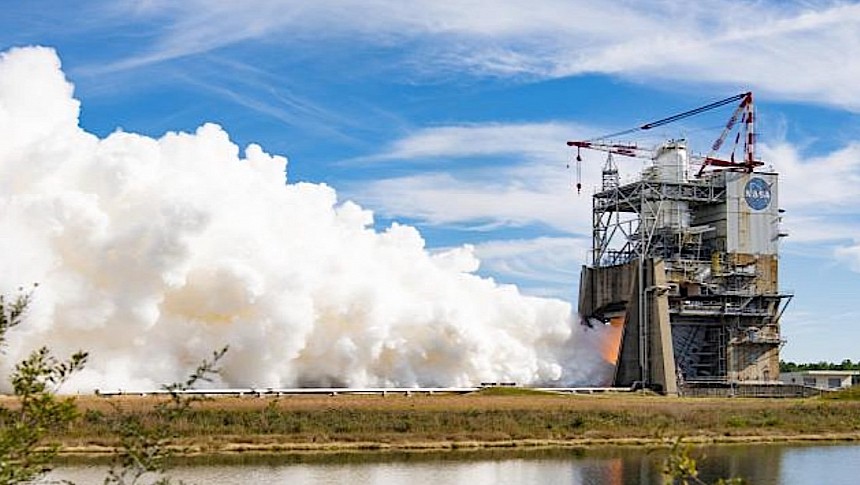Sometime in the not-so-distant future, human beings will land on the surface of Mars. It's no secret now that efforts are actively made for that to happen, and that the current Artemis Moon exploration program is only a stepping stone to the greater goal of reaching the Red Planet.
It may very well be that some private space company (see SpaceX) might get there first, either completely, with its own rocket and crew, or as part of a wider effort that will see it supply the spaceship for NASA astronauts to use.
But the American space agency is not idling around, waiting for things to happen, and it too researches means of making the long trip to Mars possible and safe. And what better way to do that than to use the Artemis program for the task?
Artemis is a long-term effort. The first four missions (with the first one already conducted last year) aim at ensuring a human return to the Moon. The ones from mission V and beyond are meant to secure our presence there, but also to pave the way to the more distant Mars.
Regardless of their greater purpose, all foreseeable NASA Artemis missions rely on proven hardware to get the job done. We've got the Space Launch System rocket and the Orion capsule, both of them brand new pieces of hardware, but ones that use tech that was in space before.
By that I mostly mean the rocket's engines. Called RS-25, they've been developed for use on the Space Shuttle, and they've proven so effective they are now the backbone of Artemis.
NASA is testing these engines separately, depending on what mission they are meant for. This story is about the RS-25s that will power Artemis V and the missions to follow, because a major milestone was just reached.
The engines for Artemis V have been undergoing testing for a while now, but at the end of November the third of 12 certification tests was passed with flying colors.
As per NASA, the test demonstrated "a key capability necessary for flight of the rocket during Artemis missions to the Moon and beyond." And that would be the engines' ability to pivot around a central point.
Such an engine maneuver, also known as gimballing, is what allows a rocket to stabilize itself once it reaches orbit, and is of course crucial for getting a spacecraft on the right course towards its target.
During the 650-second test conducted at the Stennis Space Center in St. Louis, Mississippi, an RS-25 engine successfully completed such a maneuver, while at the same time burning well beyond its intended parameters, at 113 percent power level. Technically, such a unit only needs 500 seconds and 111 percent power to push the SLS into orbit, but as with anything NASA does, a safe operating margin is always preferred.
NASA will continue to test the Artemis V engines well into 2024. Although some of the RS-25s used on Artemis I-IV missions have flown before with the Shuttle, the ones for Artemis V will be new. Since they're made using new manufacturing techniques and processes, including 3D printing, NASA's people are also looking into if and how that affects the end product.
But the American space agency is not idling around, waiting for things to happen, and it too researches means of making the long trip to Mars possible and safe. And what better way to do that than to use the Artemis program for the task?
Artemis is a long-term effort. The first four missions (with the first one already conducted last year) aim at ensuring a human return to the Moon. The ones from mission V and beyond are meant to secure our presence there, but also to pave the way to the more distant Mars.
Regardless of their greater purpose, all foreseeable NASA Artemis missions rely on proven hardware to get the job done. We've got the Space Launch System rocket and the Orion capsule, both of them brand new pieces of hardware, but ones that use tech that was in space before.
By that I mostly mean the rocket's engines. Called RS-25, they've been developed for use on the Space Shuttle, and they've proven so effective they are now the backbone of Artemis.
NASA is testing these engines separately, depending on what mission they are meant for. This story is about the RS-25s that will power Artemis V and the missions to follow, because a major milestone was just reached.
The engines for Artemis V have been undergoing testing for a while now, but at the end of November the third of 12 certification tests was passed with flying colors.
As per NASA, the test demonstrated "a key capability necessary for flight of the rocket during Artemis missions to the Moon and beyond." And that would be the engines' ability to pivot around a central point.
Such an engine maneuver, also known as gimballing, is what allows a rocket to stabilize itself once it reaches orbit, and is of course crucial for getting a spacecraft on the right course towards its target.
During the 650-second test conducted at the Stennis Space Center in St. Louis, Mississippi, an RS-25 engine successfully completed such a maneuver, while at the same time burning well beyond its intended parameters, at 113 percent power level. Technically, such a unit only needs 500 seconds and 111 percent power to push the SLS into orbit, but as with anything NASA does, a safe operating margin is always preferred.
NASA will continue to test the Artemis V engines well into 2024. Although some of the RS-25s used on Artemis I-IV missions have flown before with the Shuttle, the ones for Artemis V will be new. Since they're made using new manufacturing techniques and processes, including 3D printing, NASA's people are also looking into if and how that affects the end product.









